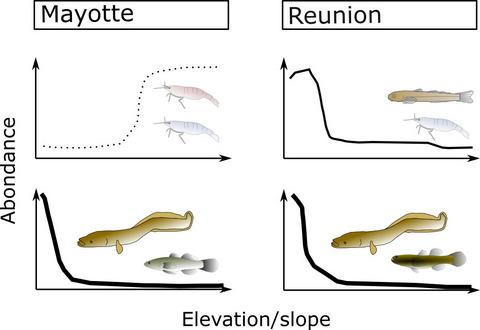当前位置:
X-MOL 学术
›
Biotropica
›
论文详情
Our official English website, www.x-mol.net, welcomes your
feedback! (Note: you will need to create a separate account there.)
Structure of small tropical island freshwater fish and crustacean communities: A niche‐or dispersal‐based process?
Biotropica ( IF 1.8 ) Pub Date : 2020-10-13 , DOI: 10.1111/btp.12865 Raphael Lagarde 1, 2 , Nils Teichert 3 , Pierre Valade 4 , Dominique Ponton 5
Biotropica ( IF 1.8 ) Pub Date : 2020-10-13 , DOI: 10.1111/btp.12865 Raphael Lagarde 1, 2 , Nils Teichert 3 , Pierre Valade 4 , Dominique Ponton 5
Affiliation

|
Determining the relative importance of niche‐ and dispersal‐based processes in the structuring of animal communities is central in ecology. Freshwater fish and crustacean communities of small tropical islands can bring new insights for understanding these processes as all their species present a pelagic larval stage which gives them important dispersal capacities. Consequently, we hypothesized that dispersal‐based process may be preponderant for structuring these communities from the regional to the local, that is, survey site, scales. Gradient forest analyses allowed us to model the effect of 12 environmental variables on freshwater taxa abundances in two southwestern Indian Ocean islands: Mayotte (26 taxa) and Reunion (21). A total of 153 surveys in Mayotte and 266 in Reunion were used for building the models. Despite the strong heterogeneity of environmental conditions between the two islands, the main factors structuring freshwater fish and crustacean communities in both islands were the elevation and the slope of the sites. The observed structure appeared more pronounced for predatory species than for primary consumers and omnivores. As predators generally have limited locomotor capacities, it is concluded that dispersal‐based process structures these communities not only at large geographical scales but also at the intra‐watershed scale, by limiting the inland penetration (or dispersion) of species in relation to their locomotor capacities. However, more knowledge concerning ecological traits and taxonomic status of many species is needed to confirm this assumption.
中文翻译:

热带小岛淡水鱼和甲壳类群落的结构:基于小生境或分散的过程?
确定基于生态位和分散的过程在动物群落结构中的相对重要性在生态学中至关重要。热带小岛上的淡水鱼类和甲壳类群落可以为了解这些过程带来新的见解,因为它们的所有物种都存在上层幼体阶段,这使它们具有重要的扩散能力。因此,我们假设基于散布的过程可能会有利于从区域到本地(即调查地点,规模)的结构化这些社区。渐变森林分析使我们能够对印度洋西南部两个岛屿:马约特岛(26个分类单元)和留尼汪岛(21个)的12个环境变量对淡水分类单元丰富度的影响进行建模。总共使用了Mayotte的153个调查和Reunion的266个调查来构建模型。尽管两个岛屿之间的环境条件存在很大差异,但构成两个岛屿中的淡水鱼和甲壳类动物群落的主要因素是这些地点的海拔和坡度。对于掠食性物种而言,观察到的结构似乎比主要的消费者和杂食动物更为明显。由于掠食者通常具有有限的运动能力,因此得出的结论是,通过限制物种相对于其运动能力的内陆渗透(或散布),这些散布的过程结构不仅在较大的地理范围内而且在集水区范围内,这些群落能力。但是,需要更多有关许多物种的生态特征和分类状态的知识来确认这一假设。构成两个岛屿中的淡水鱼和甲壳类群落的主要因素是地点的海拔和坡度。对于掠食性物种而言,观察到的结构似乎比主要的消费者和杂食动物更为明显。由于掠食者通常具有有限的运动能力,因此得出结论,基于散布的过程结构不仅限制了物种在陆地上的渗透(或散布),而且不仅在较大的地理尺度上而且在集水区范围内,都构成了这些群落的散布结构。能力。但是,需要更多有关许多物种的生态特征和分类状态的知识来确认这一假设。构成两个岛屿中的淡水鱼和甲壳类群落的主要因素是地点的海拔和坡度。对于掠食性物种而言,观察到的结构似乎比主要的消费者和杂食动物更为明显。由于掠食者通常具有有限的运动能力,因此得出的结论是,通过限制物种相对于其运动能力的内陆渗透(或散布),这些散布的过程结构不仅在较大的地理范围内而且在集水区范围内,这些群落能力。但是,需要更多有关许多物种的生态特征和分类状态的知识来确认这一假设。对于掠食性物种而言,观察到的结构似乎比主要的消费者和杂食动物更为明显。由于掠食者通常具有有限的运动能力,因此得出的结论是,通过限制物种相对于其运动能力的内陆渗透(或散布),这些散布的过程结构不仅在较大的地理范围内而且在集水区范围内,这些群落能力。但是,需要更多有关许多物种的生态特征和分类状态的知识来确认这一假设。对于掠食性物种而言,观察到的结构似乎比主要的消费者和杂食动物更为明显。由于掠食者通常具有有限的运动能力,因此得出的结论是,通过限制物种相对于其运动能力的内陆渗透(或散布),这些散布的过程结构不仅在较大的地理范围内而且在集水区范围内,这些群落能力。但是,需要更多有关许多物种的生态特征和分类状态的知识来确认这一假设。通过限制物种的内陆渗透(或散布)及其运动能力。但是,需要更多有关许多物种的生态特征和分类状态的知识来确认这一假设。通过限制物种的内陆渗透(或散布)及其运动能力。但是,需要更多有关许多物种的生态特征和分类状态的知识来确认这一假设。
更新日期:2020-10-13
中文翻译:

热带小岛淡水鱼和甲壳类群落的结构:基于小生境或分散的过程?
确定基于生态位和分散的过程在动物群落结构中的相对重要性在生态学中至关重要。热带小岛上的淡水鱼类和甲壳类群落可以为了解这些过程带来新的见解,因为它们的所有物种都存在上层幼体阶段,这使它们具有重要的扩散能力。因此,我们假设基于散布的过程可能会有利于从区域到本地(即调查地点,规模)的结构化这些社区。渐变森林分析使我们能够对印度洋西南部两个岛屿:马约特岛(26个分类单元)和留尼汪岛(21个)的12个环境变量对淡水分类单元丰富度的影响进行建模。总共使用了Mayotte的153个调查和Reunion的266个调查来构建模型。尽管两个岛屿之间的环境条件存在很大差异,但构成两个岛屿中的淡水鱼和甲壳类动物群落的主要因素是这些地点的海拔和坡度。对于掠食性物种而言,观察到的结构似乎比主要的消费者和杂食动物更为明显。由于掠食者通常具有有限的运动能力,因此得出的结论是,通过限制物种相对于其运动能力的内陆渗透(或散布),这些散布的过程结构不仅在较大的地理范围内而且在集水区范围内,这些群落能力。但是,需要更多有关许多物种的生态特征和分类状态的知识来确认这一假设。构成两个岛屿中的淡水鱼和甲壳类群落的主要因素是地点的海拔和坡度。对于掠食性物种而言,观察到的结构似乎比主要的消费者和杂食动物更为明显。由于掠食者通常具有有限的运动能力,因此得出结论,基于散布的过程结构不仅限制了物种在陆地上的渗透(或散布),而且不仅在较大的地理尺度上而且在集水区范围内,都构成了这些群落的散布结构。能力。但是,需要更多有关许多物种的生态特征和分类状态的知识来确认这一假设。构成两个岛屿中的淡水鱼和甲壳类群落的主要因素是地点的海拔和坡度。对于掠食性物种而言,观察到的结构似乎比主要的消费者和杂食动物更为明显。由于掠食者通常具有有限的运动能力,因此得出的结论是,通过限制物种相对于其运动能力的内陆渗透(或散布),这些散布的过程结构不仅在较大的地理范围内而且在集水区范围内,这些群落能力。但是,需要更多有关许多物种的生态特征和分类状态的知识来确认这一假设。对于掠食性物种而言,观察到的结构似乎比主要的消费者和杂食动物更为明显。由于掠食者通常具有有限的运动能力,因此得出的结论是,通过限制物种相对于其运动能力的内陆渗透(或散布),这些散布的过程结构不仅在较大的地理范围内而且在集水区范围内,这些群落能力。但是,需要更多有关许多物种的生态特征和分类状态的知识来确认这一假设。对于掠食性物种而言,观察到的结构似乎比主要的消费者和杂食动物更为明显。由于掠食者通常具有有限的运动能力,因此得出的结论是,通过限制物种相对于其运动能力的内陆渗透(或散布),这些散布的过程结构不仅在较大的地理范围内而且在集水区范围内,这些群落能力。但是,需要更多有关许多物种的生态特征和分类状态的知识来确认这一假设。通过限制物种的内陆渗透(或散布)及其运动能力。但是,需要更多有关许多物种的生态特征和分类状态的知识来确认这一假设。通过限制物种的内陆渗透(或散布)及其运动能力。但是,需要更多有关许多物种的生态特征和分类状态的知识来确认这一假设。











































 京公网安备 11010802027423号
京公网安备 11010802027423号